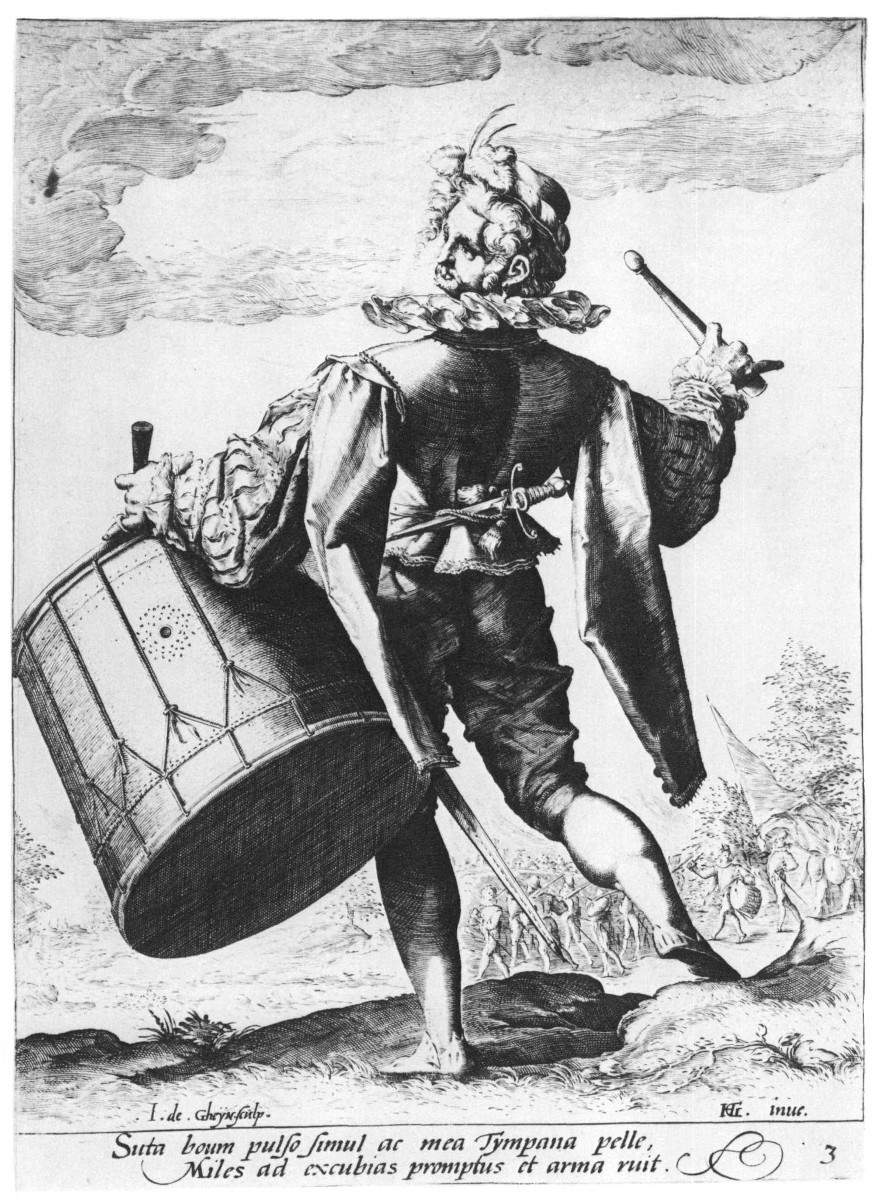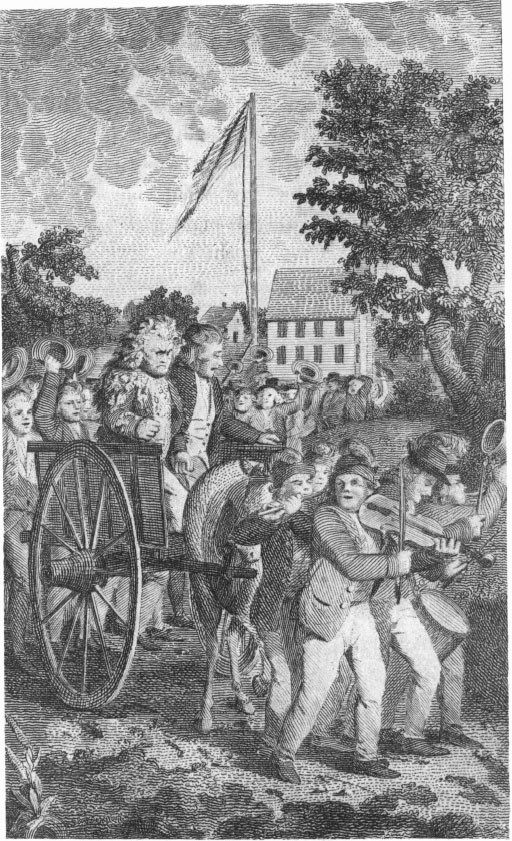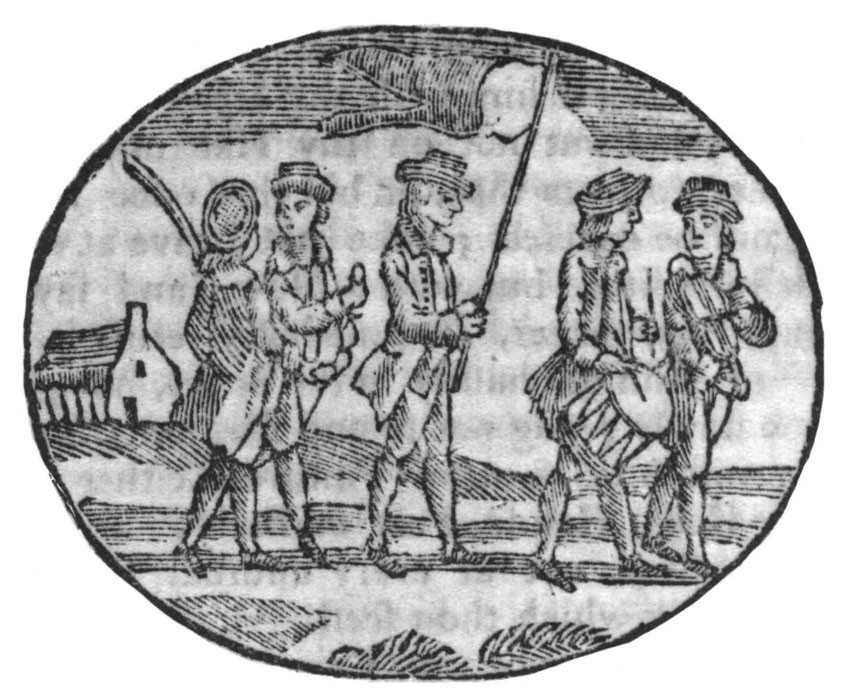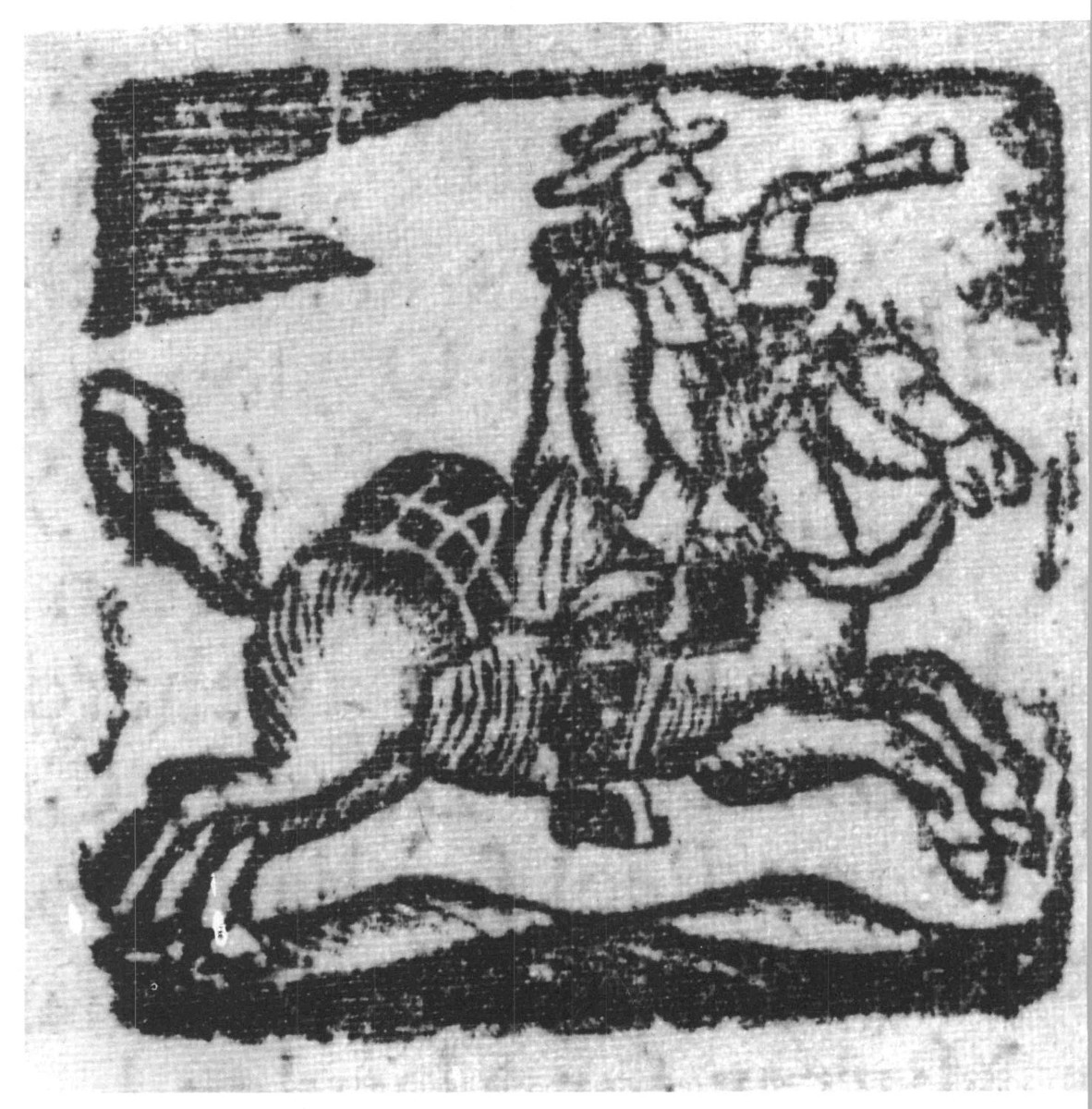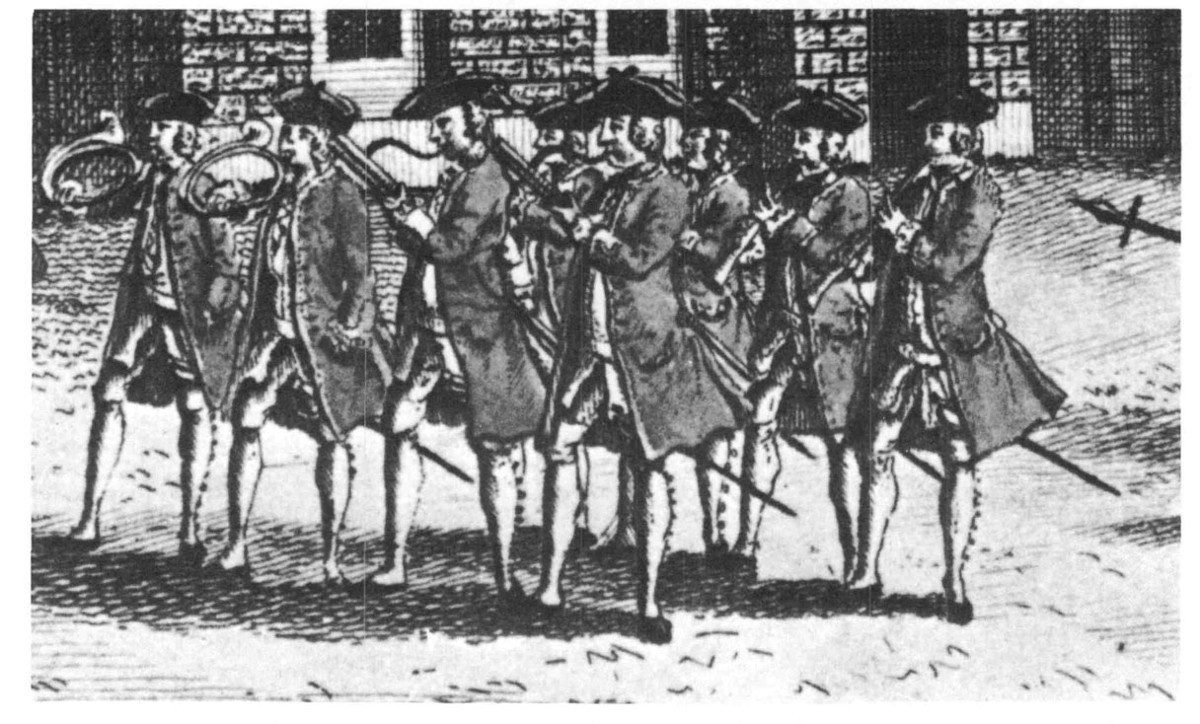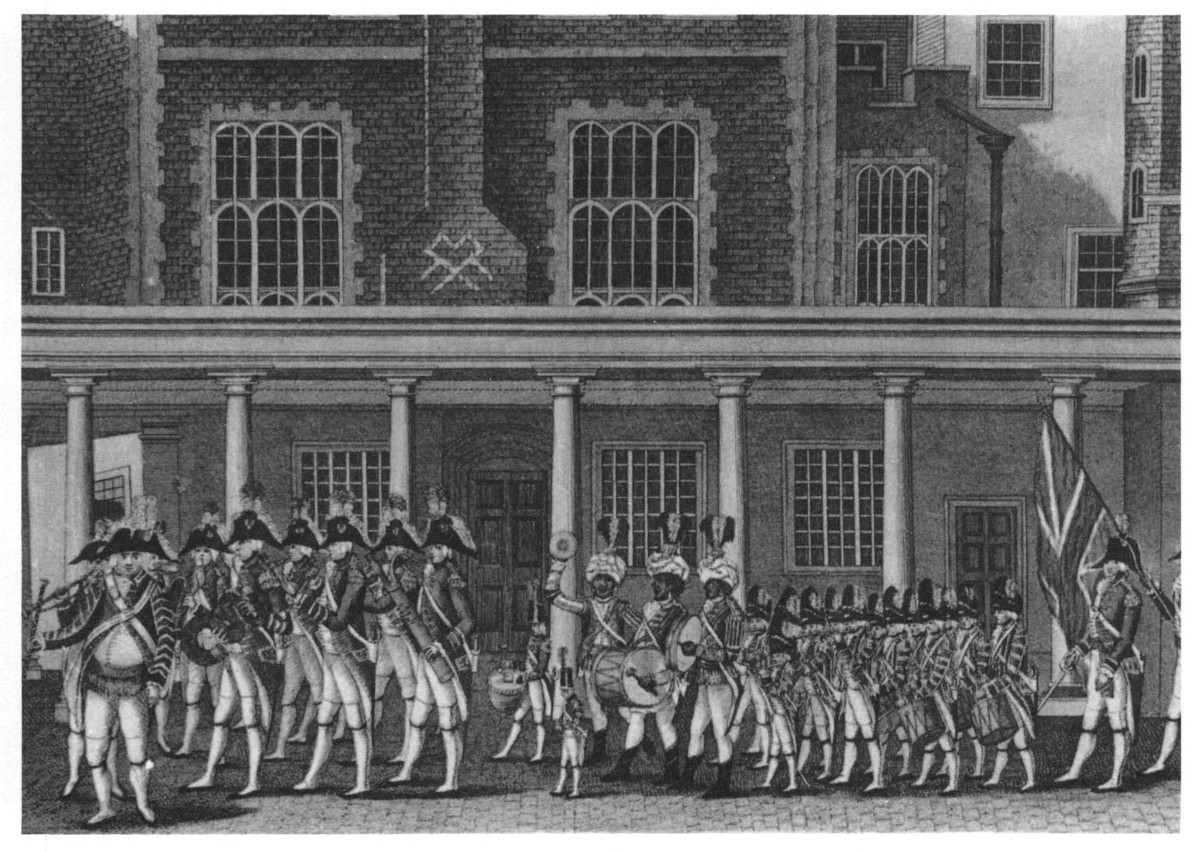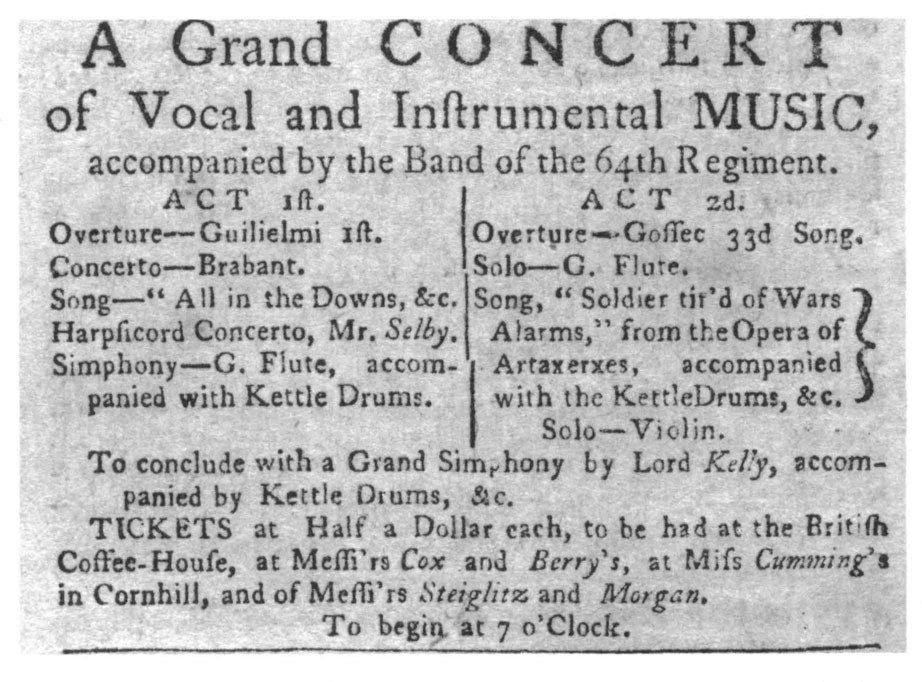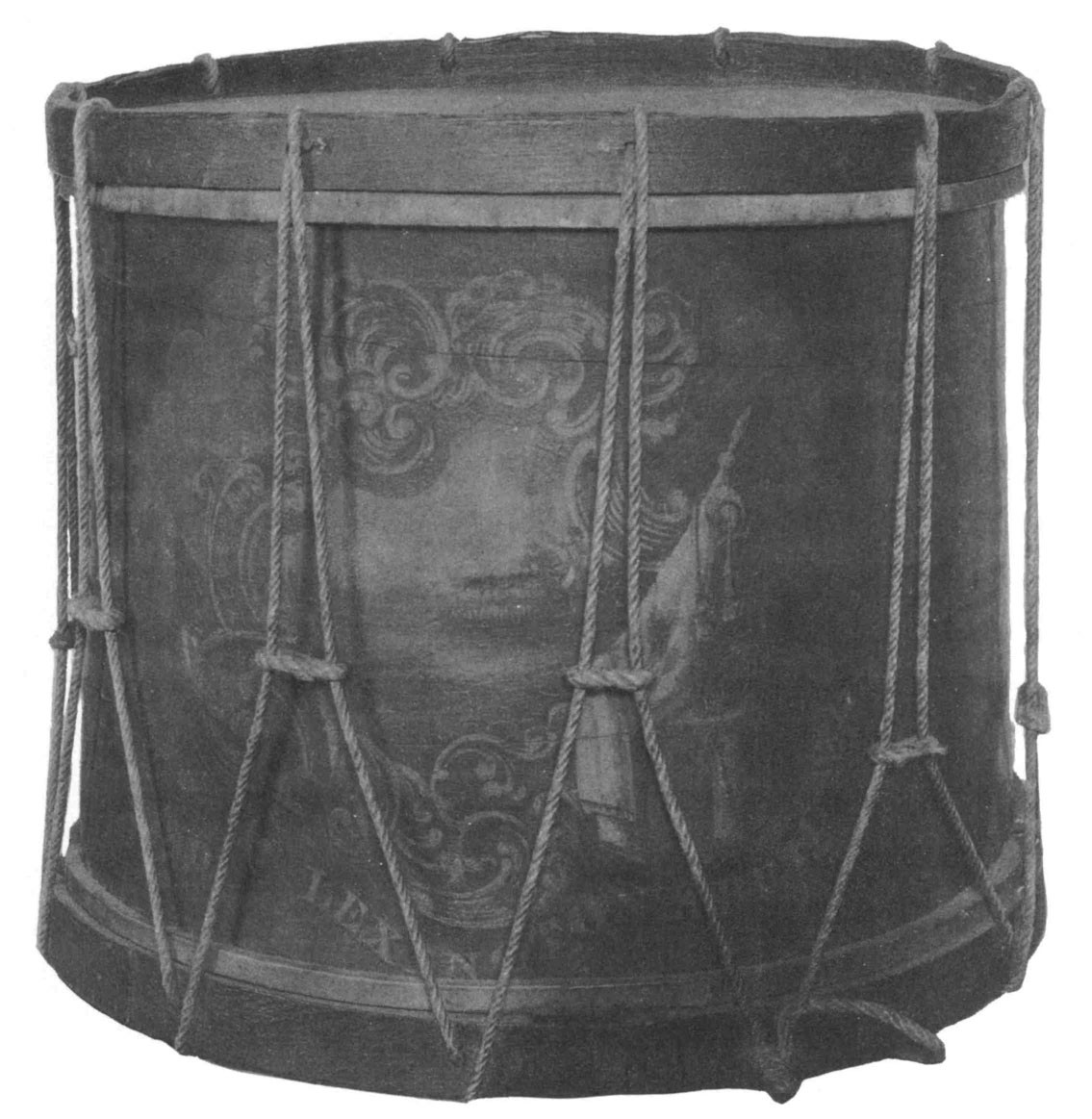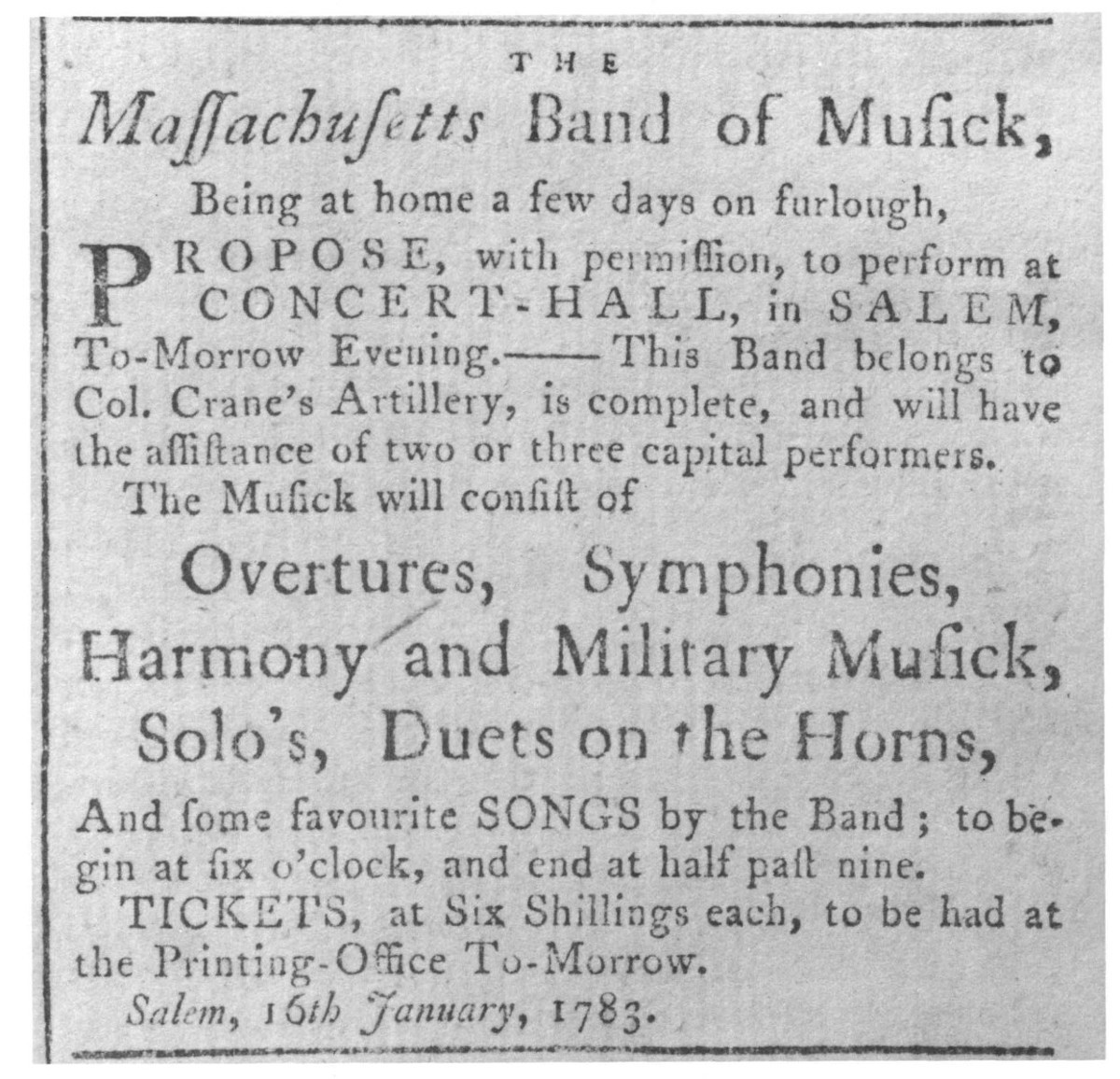Military Music of Colonial Boston
WHEN Isaack de Rasieres visited the colony of New Plymouth in 1627 he noted that “they assemble by beat of drum, each with his musket or firelock, in front of the captain’s door.” Describing the procession to the meetinghouse for religious worship, he continued, “and so they march in good order, and each sets his arms down near him. Thus they are constantly on their guard night and day.”1
This description, so typical of early settlements, indicates that the English had carried the militia system of military preparedness to the colonies. Every able-bodied man was required to contribute his part to assure the security of a society that faced the ever present danger of attack. That is, military experience was an ordinary, not extraordinary, aspect of civilian life.
The “beat of drum” introduces another everyday part of the life of the colonists. The drum was deemed an essential instrument not only for the militia, but also for other lay and religious purposes. The drum was used to warn, signal, give notices and orders. Edward Johnson commented in 1636 that the inhabitants of Cambridge “had as yet no bell to call men to meeting and therefore made use of a Drum.”2
In 1637, what is now known as the Ancient and Honorable Artillery Company of Massachusetts became the first militia company to be chartered in the western hemisphere.3 A year later Arthur Perry joined its ranks as a drummer. He was also Boston’s first recorded town drummer. Apart from the military beats which he drummed for his militia company, Perry’s drumming called the people to their meetinghouse for worship on Sundays and to lectures on Thursdays, proclaimed laws, gave notices of town meetings, auction sales, and the departure of vessels, advertised rooms for rent, children lost and found, and new importations of dry and other goods.4 Perry’s drum was probably similar to that depicted in figure 67, the standard size for the sixteenth and early seventeenth centuries, and quite different from later-style side drums.5
Besides the drum, there were other musical instruments used in connection with military and civilian functions. Samuel Sewall noted in his diary the celebration in remembrance of the king’s birthday in 1686: “some marched throw the Streets with Viols and Drums, playing and beating by turns.”6 Note that the viols and drums did not play together, but “by turns.” There is at this early date a definite distinction between the orchestral instruments, later the band, and the field music. More than a century later the New York artist Elkanah Tisdale pictured a colonial military procession in which a miscellany of instruments was used (fig. 68). The custom still continued of employing whatever musicians and instruments that were available, and so in the Tisdale etching a violin or viola and a bugle are depicted with the usual fife and drum, and in A Little Pretty Pocket-Book a violin or viola is depicted with the drum (fig. 69).
Massachusetts colonists also had brass instruments, for Sewall noted that the eighteenth century was welcomed at daybreak on the Boston Common by four trumpeters.7 They may not have been as elaborately dressed as the court trumpeters in figure 70, but the trumpets would have been of the same folded type. Another brass instrument was used by the Boston Gazette in its logo, as shown in figure 71.
Fig. 69. “A Procession,” an engraving from A Little Pretty Pocket-Book (Worcester, Mass.: Isaiah Thomas, 1788).
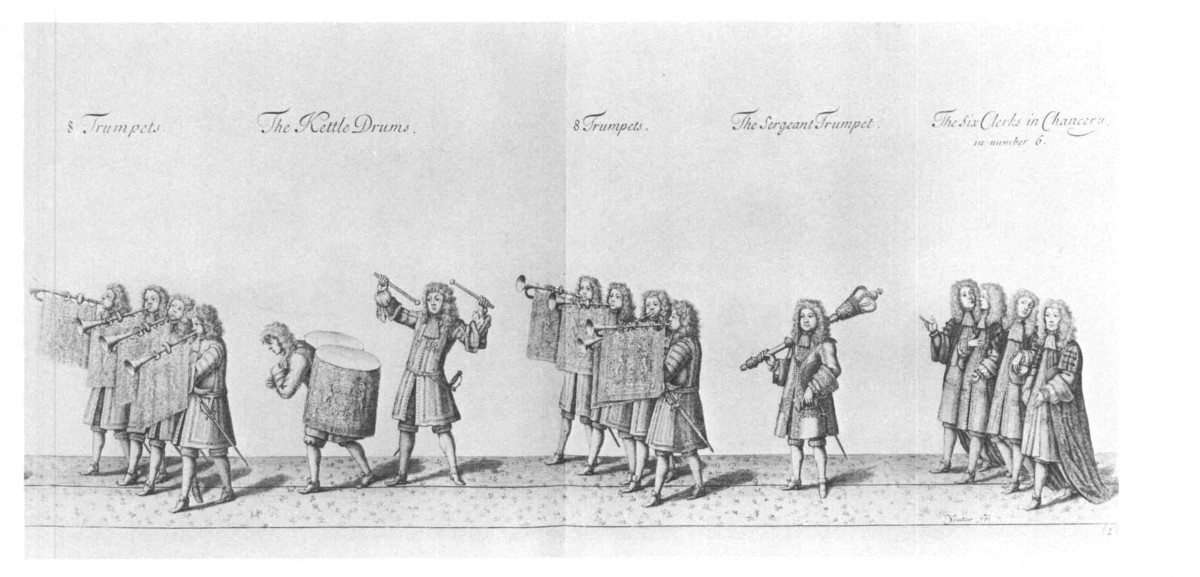
Fig. 70. “8 Trumpets, the Kettle Drums, the Sergeant Trumpet, the Six Clerks in Chancery,” an engraving by Nicholas Yeates, London, 1687.
Fig. 71. “Man with a Bugle on Horseback,” an anonymous American woodcut, logo of the Boston Gazette, 1719–1734.
Like the instruments, the music and traditions of the colonies were imported from Europe, and so it is necessary to be familiar with Old World developments in order to understand New World practices. The military band of the seventeenth century was developed in the army of Louis XIV, and consisted of three oboes and either a bass oboe or a bassoon. In an effort to reinforce the inner voices, and to add a new tone color, two French horns were added in the first quarter of the eighteenth century. At the same time one or more trumpets appeared occasionally, normally for use in flourishes or signals, but not as yet an integral part of the band.
Armies still marched to the cadence of the drum, but other instruments were added to provide interest with melody. As the number of instruments increased and their repertory likewise grew, the band tended to become an entity distinct from the regimental drummers, who along with the fifers continued as the field music. The word hautboys, from the oboes of Louis XIV, came to signify the combination of military instruments, as well as the musicians themselves, regardless of the actual instruments used. Thus a newspaper report of the “Hautboys and Fifes in Ranks” preceding Col. Benjamin Franklin in a parade of the Philadelphia Regiment in 1756 can be interpreted to mean that a band was present, not restricted to oboes alone.8
About the middle of the eighteenth century the clarinet was introduced into the band, and the instrumentation became standardized in the Western world into what is now referred to as Harmoniemusik. Until the end of the century the ideal band had pairs of oboes, clarinets, bassoons, and horns, though less affluent regiments might do without the oboes or clarinets. The number of musicians was very much a question of money, for the bandsmen were not paid by the Crown, but rather hired, uniformed, and supported by the officers of the regiment. A print of the changing of the guard in London in 1753 (fig. 72) indicates how the band was used at that time. One can clearly see the band of eight musicians which precedes a grenadier company. There are no drums visible in the picture, as those instruments were not a part of the band. The regimental drummers and fifers would be apart, remaining with their own companies and forming the field music for certain special ceremonies in the military routines of camp life.
Fig. 72. Detail from View of the Royal Building . . . St. James’s Park, London, an anonymous hand-colore engraving (London: H. Parker, 1753).
A print of the changing of the guard at St. James’s Palace, London, around 1790 (fig. 73) depicts the band in England just before the turn of the century. Comparing this print with the same changing of the guard in 1753 (fig. 72), one can see that the original Harmoniemusik combination has been altered. A serpent has been substituted for one of the bassoons in order to strengthen the bass line; a trumpet has replaced one of the clarinets or oboes, and the horn is the crooked variety instead of the earlier natural horn. The bassoon, on the other hand, appears to be a double curtal, a remnant from the sixteenth and seventeenth centuries. In front of the combined band and field music marches the drum major. His baton is a gentleman’s walking stick, more French in form than the traditional British mace. As part of the field music, he wears drummer’s lace, as do the rest of the fifers and drummers.
It was just at this time, at the end of the eighteenth century, that widespread interest in Turkish music brought additional percussion instruments into the bands. From the professional army of Turkey came the bass drum, cymbals, triangle, and tambourine. The combination of these percussion instruments was known as Janissary music. Hence, one finds in figure 73 three turbanned and costumed Negroes and two young boys playing these instruments. They follow the band, but are clearly separate. Finally comes the field music, consisting of snare drums and fifes.
Fig. 73. Detail from Changing of the Guard, St. James’s Palace, an anonymous English hand-colored engraving, ca. 1790.
It was not until after the period of the American Revolution, however, that Janissary instruments became common in Europe. Some of the French bands that came with Rochambeau in 1781 are believed to have had Janissary instruments, but no indication has as yet been found that America subscribed to the fashion until the nineteenth century.
Having looked at European developments for an understanding of American practices, one can return to the musical life of colonial Boston. As early as 1716 Edward Enstone was selling “Haut-Boys” and other musical instruments, and offering to teach all the instruments that he sold.9
Concerts were advertised in Boston newspapers from at least 1729 on, and Faneuil Hall was frequently the scene of musical performances. The musical climate of Boston must have been quite encouraging, for in 1754 the musician Stephen Deblois felt sufficiently confident of success that he built a hall “for the purposes of concerts, dancing, and other entertainments.”10
In 1764 Deblois offered almost a full range of items available in Europe at the time, including music, accessories, and musical instruments. Significant to the military historian is the inclusion in the listing of “the 55 New Militia Marches . . . and 40 Tattoos and Night Pieces for serenading (18 Divertimenti . . .) [and] Tutors for Singing and for all Instruments singly . . . by Rutherford, Johnson and Thompson.”11
The year 1764 also saw the appearance of A Collection of the Best Psalm-Tunes, in two, three, and four-parts by Josiah Flagg, engraved by Paul Revere and printed on paper manufactured in the colonies. There had been many psalmbooks published before, of course, but this marked the appearance of a musician who figured prominently in the military life of the community.
When British regiments landed in Boston on October 1, 1768, the inhabitants witnessed their entry onto the Common “with muskets charged, bayonets fixed, colours flying, drums beating, fifes &c. playing.”12 It was noted that “the Yankey Doodle Song was the Capital Piece in their Band of Music.”13 The typical British regiment of the time consisted of eight line companies and a grenadier company, with a light infantry company being added later. Each company was authorized three officers, four noncommissioned officers, forty-seven privates, and two drummers. The elite company of grenadiers was also authorized two fifers, quite frequently boys. Because of their importance as signalmen and heralds, the drummers were ranked and paid as corporals, and were usually men. Except for royal regiments, their coats were the color of the regimental facing, and were adorned with “drummer’s lace,” designed to permit their easy identification in the smoke and confusion of battle. Since the drummers gave the orders to the soldiers by means of their beatings, this was most important, and understandably not left to boys. The drum shell was the same color as the coat, and was emblazoned with the king’s cypher. Some of these details can be seen in figure 74, one of a series of paintings depicting the various uniforms of the British Army in 1751 by David Morier. The fifer, drummer, and private are from the grenadier company of the 49th Regiment of Foot, which arrived in Boston during May and June of 1775.
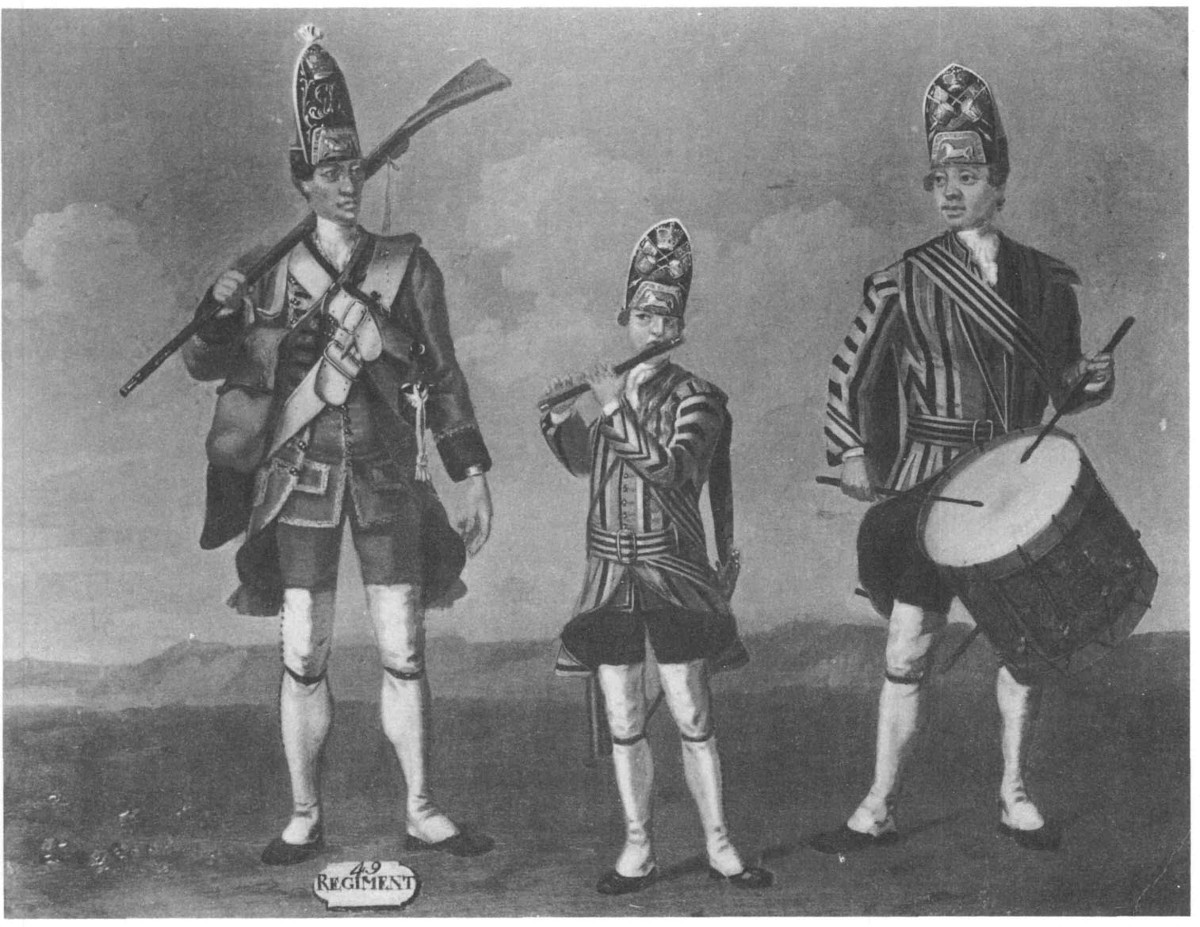
Fig. 74. 49th Regiment, a painting by David Morier, English, 1751.
In spite of their familiarity with military customs through their militia training, Bostonians were shocked and annoyed by some of the British practices. “To behold Britons scourg’d [on the Common] by Negro drummers was a new and very discouraging spectacle,” wrote the editor of the “Journal of the Times,”14 even though punishments were normally meted out by the regimental drummers. In this particular regiment, the 14th Foot, the drummers were blacks whom the colonel of the regiment had bought and trained for that duty while the regiment was stationed in the West Indies. The public execution in 1768 of a deserter from that same regiment was noted as “the first execution of the kind ever seen in this town, tho’ during the late war [1755–1763] a much larger body of troops had been encamped here.”15
Most offensive to the Bostonians, however, was the practice of changing the guards with full ceremony even on the Sabbath. Editorials repeatedly complained about worshipers being disturbed by the “drums beating and fifes playing, unheard of [on the Sabbath] before in this land.”16 By December it had reached the point that the selectmen appealed to the commanding general “to acquaint him that the music of the fife &c. on the Sabbath was very disagreeable to the inhabitants, and might have an ill effect upon the younger and more thoughtless part of the community with respect to the observance of that day, and as they apprehended it contrary to law, they expressed their hopes and desires that it might be omitted for the future, as they had taken notice it had sometimes been in stormy weather.”17 Apparently the selectmen’s appeal fell upon deaf ears, for an entry of the following day noted that “the noise of the fife was this day more general and offensive than it has been upon any Sabbath, since the troops came upon us.”18 What had been feared came to pass: the “sober inhabitants,” who had been greatly grieved by the music of the fifes and drums on the Sabbath and who feared “what unhappy effects it would have on the minds of our inconsiderate youth, and the lower class of people,” were shocked that on “the last Lord’s day our Common was covered with great numbers of people, some of whom were diverting themselves with horse-racing, &c. in the very presence of our wardens.”19
The attitude towards bands of music seemed to have been quite different, however. Not only was there no complaint about the band that performed on a Sabbath in May of 1769, but rather the band was described as “elegant,” the French horns singled out as “inimitable,” and the tune that they played was included in the account by name.20 The tune was “Nancy Dawson,” a popular ballad of the time, and the band was probably that of the 64th Regiment, since they were quite active in Boston and had been frequently described as elegant. The horns might have been mentioned because they were new to the colonial concept of a band. A few months earlier, when John Rowe was installed as grand master of Masons for North America, he noted in his diary that the procession was accompanied by “two Brass Bands of Music, the 59th & 64th Regiments.”21 On the basis of later advertisements, it is known that the 64th Regiment band had oboes, bassoons, and French horns, the standard Harmoniemusik.22 Rowe’s description of a brass band must be attributed to his familiarity with the hautboy combination (oboes and bassoons), resulting in his surprise at the appearance of the horns. These brass instruments would have made quite an impression when added to the band, both visually and aurally. Since Rowe is commenting only on the brass instruments, the implication seems clear that Boston had militia bands, but that the French horns had not as yet become regular members.
In March of 1769 a concert was given at Concert Hall for the benefit of the “Fife-Major of the 29th Regiment.”23 Rowe attended the concert, and noted that “there was a large genteel Company & the best Musick I have heard performed there.”24 The name of the fife major is not given, nor is the instrumentation or nature of the performers. The regiment is not identified further than the number, so that it might possibly have been an American militia regiment, although the British 29th Foot was in Boston at the time. In June of the same year Josiah Flagg advertised a concert which included the statement “Last Concert this season.” The fife major’s concert may have been one of the series, and performers may have been the same in both. Again the instrumentation is not specified, but the concert ended with the apparently popular “British grenadiers.”25 The musicians may have been from the 29th Foot, or they may have been from the band of the 64th Regiment, as Flagg later gave many concerts with their assistance. The men in one or both cases may even have been local musicians who were attempting to form a musical organization, for Flagg in an advertisement of 1773 claimed that he was the “First Founder, [and had] at great Expense of Time, Trouble, etc., instructed a Band of Music to perform before the Regiment of Militia in this Town.”26 Information about this early militia band has not yet surfaced, other than Flagg’s statement, but the concert of 1769 may very easily have been performed by this band.27 Flagg had seen the example of the British regimental bands, and wished to organize the same for his own militia regiment. The band may not have been very large at first, or may not have had a permanent organization, for Rowe witnessed a parade in 1770 where there were “Three Flags Flying, Drums Beating & a french Horn.”28 Colonial standards may not have been as high as European, nor the officers’ purses as full, for one-man bands were not restricted to the above-mentioned parade. Roberts wrote of the commander of the Central Militia Company who employed a one-eyed clarinetist “to march about eight paces in front” of the company.29
Since the military bands were financed by the officers of the regiment, it must be assumed that the majority of their performances were for these officers, and in the normal military ceremonial duties. It is rare therefore that one comes across references to such performances. John Rowe attended the funeral for one of his military friends at which the band of the 64th Regiment led the procession. This band also found time for concerts. In 1771 the band of the 64th performed twice at Concert Hall, the first time in conjunction with W. S. Morgan, the second with Josiah Flagg. They appeared regularly throughout 1772, 1773, and 1774, sometimes at Concert Hall and at least once at the British Coffee House. The nature of these concerts can be learned from the advertisement (fig. 75) carried in the Boston Evening Post of May 9, 1774. The actual pieces to be performed were seldom included in a concert advertisement; therefore this program is of great interest as an example of the typical concert fare of the time. It must be remembered that the military bandsmen of the eighteenth century were “double-handed,” that is, they performed on wind instruments while outdoors, and some exchanged those for stringed instruments for indoor and social occasions. This program, performed indoors, was not a band program in the modern sense, but rather a concert for orchestra.
One hopes that the musical performance was on a higher level than the printed advertisement, with its typographical errors and incompleteness. The opening work, for example, was by Pietro Guglielmi. In a set of Periodical Overtures printed by Robert Bremner around the year 1773 in London, the thirty-first work is Guglielmi’s overture La Pazzie di Orlando. Since this is the only work by Guglielmi in the whole set of parts, it may be assumed that the advertised “1st” is an error for “31st.” In the same set of six works, scored for string quartet, two oboes, and two horns, the other five are by François Joseph Gossec. Number 33 is a symphony, opus 12 number 2. In three movements, allegro, andante, and presto, it is typical of lighter orchestral music of the time. Carl Barbandt was another popular composer of the time, but which of his concertos was performed is not indicated. The song “All in the downs,” or “Black eyed Susan,” was a popular ballad in which the young lady bids farewell to her lover before he sails off to battle in his warship. Excerpts from Thomas Arne’s opera Artaxerxes were frequently performed, and most popular seems to have been the aria “The soldier tir’d of wars alarms.” The kettledrums and military uniforms of the musicians must have left a deep impression on the audience, many of them officers in His Majesty’s Service, as the soloist sang: “The Soldier tir’d of Wars Alarms forswears the clang of hostile arms. But if the brazen Trumpet sound, he burns with Conquest to be Crown’d, and dares again the field.” Thomas Erskine, Earl of Kelly, had three works published as part of the Periodical Overtures, but which one was the “Grand Simphony” [sic] that concluded the concert is not indicated.
There were British musical units active in Boston in 1774 in addition to the famous band of the 64th Regiment. A “Grand Concert of Vocal and Instrumental Music” given at Concert Hall in September of that year, by the same Morgan who had given the concerts with the 64th Regiment in previous years, featured “clarinets, Hautboys, Bassoons, French horns, Trumpets, Kettle Drums, &c., &c.” The advertisement noted that “The Gentlemen Performers of the Army, Navy, and of the Town, have promis’d Mr. Morgan their assistance in Concert; likewise some of the best Performers from the several Bands of Music of the Line.”30 This combination of the best military and civilian musical forces speaks well for the cultural integration of the city a brief seven months prior to the “shot heard round the world” at Concord, Massachusetts, on April 19, 1775. In December of 1774 Rowe attended a funeral procession that was led by the 4th Regiment and its band of music.31 They had recently arrived in Boston, and must have immediately entered into the musical activities of the city.
At the beginning of 1775 there were nine British regiments stationed in Boston, and at least eight of them are known to have had bands of music.32 Bostonians must have had many opportunities of seeing and hearing these groups perform. A visiting doctor noted in his diary for the 21st of March of that year: “After breakfast being a fine day, went to the Common & got upon the top of the High hill at the back of Mr. Hancock’s fine house. . . . It being about the time of mustering & changing guard, & the troops quartered in the different parts of the town; the Drums & Fifes, with the musick of the different regiments was heard on every side & had a most charming effect.”33
Others did not find the music quite as charming. Fifing and drumming on the Sabbath, a subject for complaints since the first British landing in 1768, seemed to be even more prevalent than before. The tune “Yankee Doodle” had been and continued to be widely used by the British as a musical taunt against the local populace. In March of 1775 there is a documented complaint that the tune was played by the field music of the 4th Regiment near a church during religious service in order to annoy the congregation.34 Also in March a colonial farmer visiting Boston was seized on a false charge. He was stripped, tarred, and feathered, and then paraded through the streets with a sign around his neck declaring him to be “American Liberty, or a Specimen of Democracy.” More important for this paper, he was accompanied by twenty fifers and drummers of the 47th Regiment playing “Yankee Doodle.”35
The colonists had been thinking militarily before the start of the Revolutionary War. T. and J. Fleet had brought out a Boston edition in 1773 of The Manual Exercise as Ordered by His Majesty in 1764, the standard military regulations for the British Army.36 That same year, 1773, Gilbert Deblois was selling “French horns, Bassoons, Hautboys, fifes, drums, English and German flutes . . . ,” with tutors for each instrument, plus “a great assortment of gold and silver Regimental and Train of Artillery Laces, Bindings, Shoulder Knots, Apaulets, Hat Loops, etc.,” swords, hangers, belts, and powder flasks. For officers seeking to form regimental bands the appeal of the instruments which could comprise Harmoniemusik adds significance to the order of the instruments named in the advertisement. Deblois’ trade card was even more explicit for it offered “Fifes, Drums, with all other Sorts Instruments proper to compose a Band of Music for a Regiment.”37
Committees of Safety had been established, and the Massachusetts Provincial Congress, like similar groups throughout the colonies, had been reorganizing the militia, forcing out Tory officers and replacing them with sympathetic leaders. A resident described in detail his impression of the new volunteer militia units:
Am almost every minute taken off with the agreeable sight of our militia companies marching into the Common, as it is a grand field day with us; and I assure, were you to see ’em, you’d scarcely believe your eyes, they are so strangely metamorphos’d. From making the most despicable appearance they now vie with the best troops in his majesties service, being dressed all in blue uniforms, with drums and fifes to each company dress’d in white uniforms trim’d in ye most elegant manner; with a company of Grenadiers in red with every other apparatus, that equal any regular Company I ever saw both in regard to appearance and discipline, having a grand band of musick consisting of eight that play nearly equal to that of the 64th. What crowns all is the Cadet company, being perfectly compleat and under the best order you can conceive of, with a band of musick likewise, that perform admirably well. What with these and Paddock’s company of artillery make ye compleatest militia in America.38
The occasion was the celebration of the birthday of the king. The troops participating were the Company of Cadets, commanded by John Hancock, with a band of music; the Company of Grenadiers with their band of music;39 the Massachusetts Artillery Company; a cavalry troop; and the “militia of the town,” or common militia. Some writers have mistakenly interpreted “band of music” to indicate a group of ten or more fifers and drummers, but this is obviously in error. The newspaper reported that “the band of music belonging to the regiment of Cadets and Major Paddock’s fifes and drums, after dinner, were in the balconies in King-Street, and alternately played a great variety of tunes before a vast number of spectators.”40 That a band of music is quite separate and distinct from the field music of drums and fifes is borne out by a report of the celebration of the king’s coronation in September of 1773. The Independent Cadets and the Company of Grenadiers, each with their own band of music, participated in the festivities, and “in the evening [there] was a grand concert of Music at Concert Hall, and a number of fireworks were played off on King Street.”41 It is very doubtful that the musically sophisticated Bostonians would be willing to attend a “grand concert” performed by fifers and drummers.
Attention is directed to the commanding officer of the Independent Cadets, Col. John Hancock, who later became president of the Continental Congress. At this time the Cadets had a band, presumably of eight musicians like that of the Grenadier Company, who played “admirably well.” A year later, when the Independent Cadets dissolved owing to the rising frictions leading to the Revolution, the musical instruments and equipage were turned over to Hancock for safekeeping until the Cadets could be reactivated.42
Preparation for any possible outbreak of hostilities continued. Companies of minutemen were established, to be ready to respond at a moment’s warning. The first call was sounded by William Diamond, a drummer in Captain Parker’s militia company from Lexington. Born in Boston, and having learned the art of drumming from a British soldier stationed there, Diamond was only nineteen when he beat the call to arms. The drum that he used, now owned by the Lexington Historical Society, is illustrated in figure 76.43
From all over New England men responded to the news from Lexington. Within a few days a conglomeration of militia units held together by common ideals, but little else, began a siege of Boston. The Massachusetts Provincial Congress resolved that eight thousand men be immediately enlisted and formed into companies of seventy-nine men each, including one drummer and one fifer, nine companies forming a regiment.44 New Hampshire sent regiments of ten and twelve companies, Maryland of eight companies, and a Canadian regiment reported with twenty.45 There was no standardization of size among the units, but all depended upon the drum for communicating orders.
By March of 1776 the British situation in Boston had become untenable and Gen. Howe decided to evacuate all his troops. As the Americans entered Boston, they marched to the tune of “Yankee Doodle,” and traversed the town from end to end with “drums beating and colors flying.”46 Fearing that New York might be the next objective, Gen. Washington ordered the majority of his army to that city, leaving Gen. Artemas Ward in command of six regiments in and around Boston for the protection of the entire area.47
Within two weeks of assuming command he ordered that his chief executive officer, the brigade major, set up his office in the general’s own quarters, and that the “drums-and-fifes majors of the whole brigade” meet in that office on the following day.48 The orders for that day read to the troops at retreat parade contained the statement that “the General [Ward] observes with pleasure the improvement the drums and fifes have made in martial music, and their attention to duty. He hopes that the drum-and-fife majors will continue to exert themselves in instructing those under their care in every branch of their duty.”49 To ensure that the fife and drum majors would continue “to exert themselves,” a chief drum major, Hugh Rayner, and a chief fife major, John Whiting, were appointed on the very next day. So that there would be no question in anyone’s mind as to the importance placed on the music, explicit details were also given:
All the drums and fifes in town are to attend the stated exercises at the time and place appointed. All the drums-and-fifers majors of this division of the army are to meet twice a week, on Tuesday and Friday, on the bottom of the Common, for practice. The drums and fifes of each regiment off duty are to practice separately, under the direction of their respective majors, till the chief drum-and-fife majors shall think them sufficiently instructed to join in one body. It is recommended the musicianers of each regiment that they emulate each other in striving to excel in this pleasant part of military discipline.50
To reinforce the total effect of this drive, Ward decreed that the next day’s parole, or sentry’s challenge, would be “martial.” to be answered by the countersign “music.”51 This concentrated emphasis in a brief four days seems to have had its effect, for no further mention of music is contained in the orderly book.
It will be remembered that, two years before, the musical instruments of the band of the Independent Cadets had been turned over to its commander, John Hancock, for safekeeping until such time as the Cadets could be reconstituted. Some other officers had different ideas, and took advantage of the situation. Writing from Philadelphia, where he was serving as president of the Continental Congress, John Hancock requested a favor of Gen. Philip Schuyler:
On the Departure of our Troops from Boston, to New York, Colo Greaton & I believe some other of the Cols from my Colony, Without my Knowledge or Consent took into their Possession & out of the hands of the proper officer with whom I had left them, some French horns, Bassoons & other Instruments of Musick which I purpose imported for the use of a Military Corps under my command. I have to request the Favor of you to Give Orders to Colo Greaton, or any officer who may have them, to deliver them to you. I shall esteem it a Favor, if you have any good opportunity, You would please to order them to be sent to me. I believe you will find my name on them.52
Gen. Schuyler was at the time away from the main part of the army, so he requested his second-in-command, Gen. Gates, to collect the instruments and forward them to his house at Albany.53 Schuyler then wrote to Philadelphia of his instructions to Gates, and hoped that he would soon be able to forward the instruments to Hancock.54 He does not seem to have been successful, for six months later Hancock reminded Schuyler, “I never heard anything of my band of musick since I wrote you.”55 Schuyler’s correspondence does not indicate a reply, nor does Gates’ correspondence make any reference to the request. Nothing more has been located regarding these instruments. Col. Greaton commanded the 24th Continental Infantry, later the 3d Massachusetts, and it is very possible that the instruments remained with the regiment and were used by a band, although no documentation regarding this has as yet been located.
Boston remained peaceful after Howe left in March of 1776, and their distance from the actual site of warfare seems to have given the Bostonians some sense of assurance that military preparations were no longer an emergency. On May 29, 1777, the following order was given to the troops in Boston:
The Honble House of Representatives having represented that the frequent Drumming around and near the Court House greatly interrupts the Debates of the Assembly, and desire that a stop may be put thereto, the General therefore forbids any Beating of Drums during the sitting of the Council or House of Representatives (except on some special occasions) either for practicing or on Duty, above the Coffee House in Congress Street, or between the Old Brick Meeting House, and the Town Pump in Main Street. Fife Major Hywill will fix a parade for the Musick of Colo Crane’s Battalion, somewhere without the before mentioned Limits.56
The fife major referred to in the orders was John Hiwell, who had been appointed to that position in Knox’s Regiment of Continental Artillery on February 1, 1776.57 Prior to that time he had been a sergeant,58 but little else is known about his early life. On January 1, 1777, according to Heitman, Hiwell had been promoted to the rank of second lieutenant,59 yet the above order refers to him as fife major. It is very possible, in the light of subsequent events, that Hiwell carried on the duties of fife major, with the rank, pay, and allowances of a second lieutenant. A likely justification for this extra consideration is that he was responsible for the regimental band of music. If only the fifes and drums were meant, there would be no need to single out Hiwell and “the Musick of Colo Crane’s Battalion” in the above-quoted order. Artillery officers and men have always considered themselves apart from and above the regular infantry of the line and Col. John Crane’s Massachusetts battalion was the 3d Regiment of Continental Artillery. Thus it would not be surprising to find documentation that this regiment supported a band of music. Since it is known that Crane had a band of music in 1778,60 one can be fairly certain that the above order documents the existence of the band a year earlier.
In June of 1777, less than a month after the above order was given, Hiwell received 180 dollars from Col. Crane “to recruit men for his Reg. of Arty.”61 At that time a Continental bounty of twenty dollars and one hundred acres of land was offered to anyone who enlisted for the duration of the war, and ten dollars to anyone enlisting for three years.62 Since Hiwell was fife major, presumably he was sent to enlist musicians. Considering that Hiwell was a skilled musician63 and that the drum major would logically be in charge of recruiting drummers, it is likely that Hiwell was trying to recruit additional men for the regimental band.
In 1778 Hiwell was appointed as inspector and superintendent of music for the Continental Army, with the pay and allowances of a captain of Artillery.64 He was still responsible for the 3d Artillery Band, however, and supervised its many performances at social and ceremonial occasions while the regiment served in the Revolution. There are many instances where Crane’s band is mentioned, always with favorable comments as to the musicians’ ability.65
Following the surrender at Yorktown in October of 1781, there was little organized fighting, particularly in the North. Not wishing to disband completely his army prior to the formal acceptance of a peace treaty, Washington decided to grant furloughs, thereby maintaining the organization of the army. Having functioned as a unit for so many years, the members of Crane’s band remained together even while home on leave. The Salem Gazette of January 16, 1783, carried the announcement illustrated in figure 77. Hiwell had drawn two clarinets and cane for bassoon reeds from the commissary specifically for Crane’s band, and the advertisement mentioned “Duets on the Horns,” so that the band must have been the standard Harmoniemusik combination of pairs of oboes, clarinets, bassoons, and horns, similar to the style accepted by the European bands.
The concert was performed “at so great acceptance” that the band was engaged to assist in a concert for the poor the following week. Less than a month later the band performed a similar concert at Portsmouth,66 which is noted as being the “first real public concert recorded in New Hampshire.”67
The band returned to the regiment in time for the announcement of the cessation of hostilities on April 19, 1783, and finally the day arrived for which the men had been waiting so patiently: “Regimental Orders, 9th June 83. . . . The men engaged during the war are to parade tomorrow morning 10 o’clock before Col[onel’s] Quarters—prepared to march to their respective homes—. . . The Non Commissioned Staff and Band are to [be] furnished with Musketts and Accoutrements from the 3 years men. . . .”68
Certainly the musicians must have continued playing when they got back home, for there are many references to “the Massachusetts Band” performing in Boston. Richard Franko Goldman has traced a direct relationship between this band of Col. John Crane and that of Patrick S. Gilmore, almost a century later: “The Massachusetts Band was formed in Boston in 1783; it was known from about 1812 as The Green Dragon Band, changing its name again in about 1820, to the Boston Brigade Band. It was this band that became, in 1859, Gilmore’s Band, the first great American band and undoubtedly one of the finest that has ever played.”69 Whether or not Goldman’s lineage is correct, colonial military bands were to form a significant part of the musical heritage bequeathed to post-Revolutionary America.

